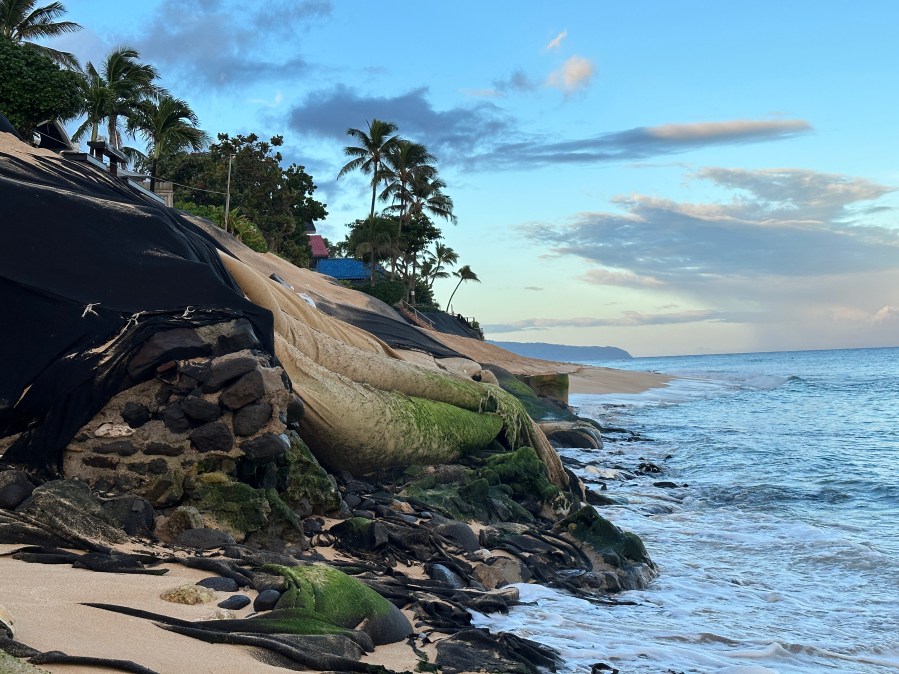HONOLULU, Hawaii (KHON2) — Extra large surf is heading towards north-facing shores next week and is expected to stick around for several days.
It’s already been a tough year for beachfront homeowners, especially on Oahu’s North Shore where two homes were demolished after nearly falling into the ocean a few months ago.
On Friday, the Board of Land and Natural Resources stood by a decision not to allow private landowners to harden public beaches for their own personal gain.
Many West Maui beaches have been facing severe erosion for over a decade.
Back in 2007, the Office of Conservation and Coastal Lands issued the Hololani in Kahana an emergency permit for sandbags to protect their building from erosion.
In 2018, the BLNR required the building to come up with a long-term solution and that solution involved a 400-foot steel sheet pile wall and rock revetment.
The project was approved by BLNR in 2018, before Act 16 was passed in 2020 which prohibits shoreline hardening on sandy beaches.
“Those decisions have been made and this is, now are we going to let them to use state land? Or give them use of state land to do all the things they’ve already gotten approvals for?” BLNR Chair Dawn Chang said to the board members who seemed torn on the decision.
“I’m also concerned of the optics of this because we fined owners a considerable amount of money for hardening their properties,” explained BLNR member Kaiwi Yoon. “So, I think this sends an unclear message, and it’s messy all the way around to me.”
Hololani’s emergency permit from OCCL is set to expire in 2025.
“I hear the concern about the board sending a double message,” explained OCCL Administrator Michael Cain. “But sometimes we do have to act on permits that we wouldn’t have recommended today.”
A board member asked him why the state no longer supports armoring the shoreline.
“We’ve known for over 100 years that shoreline armoring can negatively impact beach properties,” explained Cain.
Hololani tenants told the board they only wanted to replace the existing structure with a safer one.
“We’re not asking for something new,” said Hololani resident Spencer Schermling. “We’re just replacing something that’s already there and making it better and it will make it easier for people to get to ocean.”
Chairwoman Chang said private landowners keep asking the BLNR to build on state public land.
“I think the problem is many land owners knew more than 20 years ago this was inevitably going to happen,” she said. “So you wait until a crisis, and yes you have very few options, and now we see what’s happening Kaanapali, in Kahana and statewide, so this, as a general matter, we would ask all landowners to begin to start looking in a more proactive way instead of waiting for a crisis to occur.”
Chang noted the difficult decision for the board to make and members went into executive session.
“I see this as part of a much larger picture but I need to see greater commitment from private landowners along Kaanapali that you’re working towards a long-term solution and I haven’t seen enough of that other than we’re going to protect our own property,” Chang added.
She said the BLNR’s mission is to preserve and protect natural resources and public access. “I’m always struggling with how do we find that balance, especially with shoreline issues, private landowners want to protect private property, but it is in situations like this where it comes at a cost to the public because these structures are prohibiting safe public access,” she added.
The attorney for Hololani argued there was no one size fits all solution for all the erosion statewide.
In the end, the board voted four to three, denying Hololani’s right of entry and construction request.
“I think the message that BLNR sent was that it is not the state’s legal obligation to protect these property owners who are really just investors, and off-island speculators,” said West Maui community activist Kai Nishiki. “It’s not the state’s obligation to protect coastal properties, it’s the state obligation to protect our public trust resources.”
“I think it sends a strong message to all of those those who own coastal properties that we really need to be getting together with the agencies and with the communities that are doing business in, and we need to come up with adaptation pathways, pathways where we are supporting the landward migration of our beaches,” Nishiki added.
